My friend Cory said he heard a tiny scrap of laughter out his window the other night, and it made him want to cry, thinking of all the pleasures happening elsewhere. The last days of Summer should be the last sweet drops of a long mirth. Your soul should be like a Gatsby lawn party. Yes, hold on to your laughs; they’re all sweaty and slippery; they’ve been on ice all summer, trying to keep cool, trying not to become sighs.
Things that will never be the same, and summer, and death, and mirth, and flings long past: all one big complex of crap. Go ahead and try to sum it all up. If I was working at the Whitney staging a retrospective of my summer past, the Summer of No Blogging (thanks for pointing that out, everyone that I know!), it would mainly consist of a performance art piece entitled Practicing Maniac. Various rooms: always the same maniac. Occasionally an adorable dog sat on this maniac’s lap, expressing appreciation through furtive licks.

Many hours died, one after another, sacrificed at the altar of a few minutes of music; now all that time, all that existence and memory has been transmuted into increased capacity for playing those few minutes: it better damned well sound good. But, no pressure!
Suppose you’re just practicing innocently along, telling yourself “hey I’m practicing” and also “I’m such a good person for not surfing the internet,” etc. etc., when the composer hits you with this:

In case you don’t know, three f’s is the loudest dynamic you would “normally” come across. Ligeti writes eight, which translates to a wonderfully silly Italian sussuration: Fortissississississississimo. My initial reaction to this is: the composer is a jerk. But I often have this reaction. Resenting the composer (usually dead, but not always!) is a fun practice tactic, something productive I’ve been able to pass on to my students.
How to interpret eight fortes? I think maybe I should hurl my whole body at the piano as violently as possible and hope for the best. They would find my bloody corpse weeks later amid the moldy coffee cups, odiferous testament to my devotion to the composer’s intent. How would 8 be different from 7? Both must be so searingly loud as to be painful, a distinction between degrees of agony: if 7 fortes is like being disemboweled by a wolf, then 8 is like being disemboweled by a bear.
Ridiculously, staggeringly loud is one brute brand of infinity, but the best infinities in Ligeti are infinities of thought. He starts with a principle, a procedure. The procedure proceeds. But at some point, preferably just at the birth of complacency, Ligeti accelerates or compresses, he turns the mental dial to eleven. The code destabilizes itself.
A good example: the sixth Etude, Automne a Varsovie. The principle is descending chromatic lines. At first there is only the one line, falling, falling:
Audio clip: Adobe Flash Player (version 9 or above) is required to play this audio clip. Download the latest version here. You also need to have JavaScript enabled in your browser.
But gradually other chromatic lines come in, at various other speeds. In this middlegame, the effect is just like that of many familiar Western musical masterpieces: a meditation on the beauty of various chromatic lines, intersecting, falling at different rates. These beauties are always elusive, because the lines are always passing on, but then (such is the cycle of things) new temporary beauties also always keep coming.
However, the urge of the piece is not beauty, but an ever-denser thicket of lines, crowding beauty out. Accumulation keeps threatening pleasure. The lines become insanely intertwined, and the Etude follows this logic or urge to its desperate, natural conclusion: the pianist rushes off the bottom edge of the keyboard, chromatically, as loud as possible, breaks off, as short as possible. The idea of the piece (the descending line) has fused into a white-hot singularity, something that can no longer be discretely played or thought, something infinitely forceful … after which nothing can be said, violent caesura, silence.

Now, this sort of thing happens in Ligeti so often that it becomes commonplace. He’s intimate with infinity, comfortable with destruction; infinity’s like the 7-11 he stops at on his way home from work, to pick up a Big Gulp.
One thing Ligeti’s doing is challenging the pianist to ape a machine; he evokes the (seemingly) infinite calculations we are used to our PCs doing for us every day. Perversely, he wants to see us try to do them. But this machine desire is not heartless, or bloodless. Rather, it’s a thrilling, terrifying, uncompromising ride towards where you won’t be able to do it any more. (Aren’t we all on one of those?) It’s the life-affirming death-wish of the work.
The death of your typical tonal work (say, by Mozart) is a cadence. You have a movement, and if it starts in a key X, it will end with a cadence in key X. There’s no bones about it; that’s just how you close things off, say farewell; it’s “the law.” The cadence is a cage which defines and restrains so much of classical music. Ligeti’s runs for infinity are so common that they assume the role of cadences. His way of achieving closure is to explode the premise of the piece (or allow the premise to destroy itself). Going berserk on idea X is the inevitable, natural conclusion of it; the parameters of a piece lie at the far end of an apocalypse, of the unthinkable.
What with Ligeti’s freedom to go beserk, you might find yourself pitying poor finite Mozart.
For instance, one of the greatest Mozart slow movements (second movement of K 533) begins with a very finite, very simple measure:
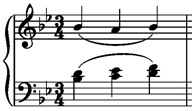
Audio clip: Adobe Flash Player (version 9 or above) is required to play this audio clip. Download the latest version here. You also need to have JavaScript enabled in your browser.
… nothing extraordinary, nothing more than lovely passing through B-flat major. It’s almost an emblem of the limitations of Classical Slow Movements, you’re already thinking, oh no, not another one of those pretty, precious things. But the second measure comes out of left field:
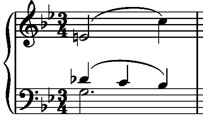
Audio clip: Adobe Flash Player (version 9 or above) is required to play this audio clip. Download the latest version here. You also need to have JavaScript enabled in your browser.
… a disjunction, two notes that do not belong, a couple of strange ugly leaps, cross-relations, a middle voice suddenly expressive and prominent where it had been filler. There is a lot to contemplate here, but not much time; immediately, the third section of the phrase resolves this “problem” away, as if nothing had happened:

Audio clip: Adobe Flash Player (version 9 or above) is required to play this audio clip. Download the latest version here. You also need to have JavaScript enabled in your browser.
But something HAS happened. And when the next phrase begins, we have a strange sudden distance between two notes in the right hand and an octave in the left:
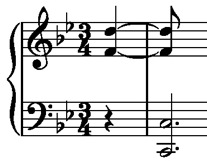
Audio clip: Adobe Flash Player (version 9 or above) is required to play this audio clip. Download the latest version here. You also need to have JavaScript enabled in your browser.
… I don’t think you can separate this Weird Event from the previous Weird Event. Those weirdnesses are not coincidences, they’re collaborators, pushing us away from the “normal” which was so clearly promised in the opening measure, sabotaging the cadences which surround them. Mozart’s giving us two kinds of Weird. One is the infection of the major key with the minor: a kind of confusion, or ambivalence. The other is more technical perhaps, harder to explain: a kind of austere voicing in which the lines feel a bit too distant from each other, in which a sudden gap is felt. If you think of a nice lyrical texture as a number of voices filling each other out, like a ripe juicy fruit, depending on continuity, completeness, flesh passing to flesh … these gaps are like moments where some of the flesh of the fruit vanishes and some sort of diagram or skeleton appears behind it.
I (probably) wouldn’t go into these first four measures so verbosely, if it weren’t just the beginning of a long, harrowing process, the process of Mozart drawing connections between weirdnesses, allowing the weird to flourish. The minor keeps forcing its way into the major key (and vice versa), a process which reaches a spectacular climax here:
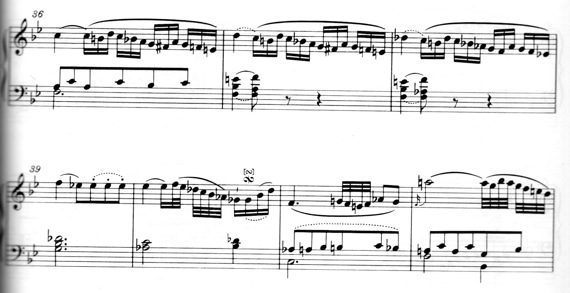
Audio clip: Adobe Flash Player (version 9 or above) is required to play this audio clip. Download the latest version here. You also need to have JavaScript enabled in your browser.
Mozart couldn’t have crammed more major-minor ambiguity into this passage if he tried: in the context of the style, it’s infinitely ambivalent. He only escapes from this thorny confusion of happy and sad through an extraordinary sudden gap, the melody leaping up a tenth to the major key: that is, one weird rescuing us from another.
In the middle of the movement, Mozart creates a climax of austerity (weirdness #2). He embarks on an endless, strange passage of sequences and dissonances, in which the ideal of the human voice disappears, we wander into a contrapuntal maze:

Audio clip: Adobe Flash Player (version 9 or above) is required to play this audio clip. Download the latest version here. You also need to have JavaScript enabled in your browser.
Mozart’s slow movement is not that different from Ligeti’s Automne a Varsovie! Its beauties contain destabilizing elements which spread, increase, threaten to take over. As you listen to this Andante, even for the nth time, those odd things are odd enough not to become familiar … like an unsettling face. Some angle of the face is never quite right, no matter how you try to organize it in your mind, and if you manage to get used to one crooked eye then everything else will seem askew.
All summer, in my maniacal practice sessions, I switched back and forth from Ligeti Etudes to Mozart 533: I kept putting Pandora back in the box, then letting Her out again. Ligeti does “scientific” infinity: he gestures at “actual” infinity by rushing off the top or bottom of the keyboard, or allowing voices to replicate themselves, or mimicking mathematical ideas, permutations, chaos theory, etc. etc. I found myself trying to identify infinity in Mozart, feeling strongly it was there. For many people, I imagine, the infinity of Mozart lies in his perfection, balance, symmetry, the whole shtick of the classical ideal. Not me.
Infinity is something you’re in awe of, which seems impossible, but (like a horizon) is there all the time, defining your every step. I find infinity not in Mozart’s continuity, but in his gaps, ambivalences, in glimpses, in the leap from one image or idea to another. If the cadence and the style is a box, a scaffolding, the four-bar phrases, the whole rigmarole of compositional framework … then music’s a box for holding infinities, momentary infinities. How do they fit in there? They’re hiding in the corners of phrases, behind barely touched-upon moments, which imply vast other things. Ligeti’s infinity is overt; it hits you over the head and leaves you spinning. Infinity in Mozart is a golden fish swimming in the stream of the finite, impossible to catch, but you must try.

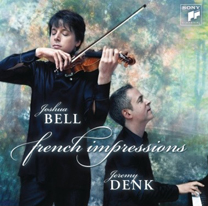

45 Comments
K. 533 is such a swell piece and the idea of switching between it and the Ligeti is terrific. If you have the chance, please write about the third movement (where M. — among many other things — takes sequencing to an absurdly playful extreme.)
ffffffff looks like a record, according to the always entertaining Extremes of Conventional Music Notation site at http://www.informatics.indiana.edu/donbyrd/CMNExtremes.htm.
Well, you want to play the ffffffff pretty loud, all right, but hold back a little, just in case the composer wants to get louder later on.
welcome back to the blog, jeremy. we missed you! you were brilliant at tanglewood!
“I find infinity not in Mozart’s continuity, but in his gaps, ambivalences, in glimpses, in the leap from one image or idea to another.” Interesting. Will have to recalibrate my listening next time Mozart’s on dock and keep my ears open for that golden fish. So, which of the two (L or M) makes for the better Buzz Lightyear? Hmmmm??
PS. Welcome back – your absence was felt.
PPS. If you consider that 10 f’s might be like “the heavens are parting and Jesus is coming” loud, then if you dial it back to 8 it might be more like “blood is about to explode from your eyes” loud. Not pretty, but survivable.
My feelings about this entry are best represented by Alice, of Wonderland, who said upon reading Jabberwocky,
“It seems very pretty but it is rather hard to understand! Somehow it seems to fill my head with ideas–only I don’t know what they are!”
And yet, somehow, your mellifluous blogwords have made me feel vaguely ready to write two (more) pages on the subject of Freedom as an African value as expressed in music through improvisation. It was due a week ago. You are a covert inspiration to procrastinators everywhere (and Lord knows we need inspiration.)
I am coming to your concert in Berkeley so practice a lot, because those tickets are expensive. But also blog. And, here’s a little something I’ve learned: be sure to set aside some “Jeremy time” each week. Eat a steak dinner in the tub while enjoying the soothing splashes, flutings, and birdcalls of your favorite “Nature Sounds” CD. You are worth it!
-Nate B.H.
Thank GOD (or infinity or whatever) that you didn’t type rig-A-marole. Such a treat. For those irked at the Summer of No Blogging, I want to say that (long ago) I accepted that to check more than once every couple of months was a wasted click. It’s been amazing how I seem to know when to check. Only 5 days late this time!
Well, at least the musical scale of loudness is not logarithmic like the Richter scale. Those eight fortes could cause quite a bit of death and destruction, I’m sure. Splendid to see you back writing on ThinkDenk!
Dear Jeremy,
It does sound damn good indeed. I noticed that in response to the ever predictable question at the kiddie concerts at the Y, your reported hours of practice were on the decline. How about those string players with their two hours a day?! This trend made me somewhat miserable considering your staggering repertoire (most memorized) and my feeble efforts at the keyboard. So thanks for sharing.
I am really looking forward to hearing you erupt in those first bars of the Liszt e flat concerto. Beginnings are so hard! Take my breath away – I know you can.
Do you think Ligeti chose 8 fortes because the number 8 tipped on it’s side is the infinity sign?
Lucky doggy!
I eschew any music that could potentially (and permanently) degrade my hearing acuity.
I’m going to be at one of your concerts next month. Please please come out accessorized with a black and white puppy.
Please, call a tuner!
As for Ligeti and 8 f’s – in reality, there is no difference between even ffff and ffffffff – and we all know it, don’t we? Composers have been jerks lately – after Mozart, there are not too many ways how to make your music interesting…
Difference between Mozart and Ligeti? Simple. Almost everybody knows, if you don’t play almost exactly what Mozart wrote. Almost nobody knows, if you play almost whatever in Ligeti.
Beautifully put! For me, Ligeti’s piano etudes are about the journey — not the destination. My favorite, “Desordre” undergoes something quite similar (I wrote about it here http://bit.ly/cQGxh3).
I like the Mozart analysis — those miniature bites of dissonance, lend a nice contrast to the tonal parts. My theory teacher (who was a big fan of Ives) said “you can write the most beautiful melodies in the world, but if it is the entire piece’s disposition, you find that the beautiful begins to dull. To accent, use contrast.” Then he would play some lovely hymnal Ives piece with some top-end dissonance in the right hand, that would take the listener by surprise. I think this holds some truth, and as you can see by these two composers, sometimes disconnect is more pleasing than the straight-forward narrative of the cadence.
Do you suppose Victor Borge ever played the Ligeti etude, with fivetissississississississimos, of course? Thanks for the great post — hope to see you at the Y in December.
Hi! I am glad you are blogging again, and I think your expression of why Mozart is interesting is the closest anyone has come to making me want to listen to it.
This is the first blog post of yours I have ever read, having been led to it by today’s NY Times article about you and Ives. I loved what you said about Ives there, and I loved what you said about Mozart here. Thanks for de-jading this old musical freelancer, if only for a few moments.
Your LIszt was out of this world!! Stunning, outrageous, magic. Thank you so much
I certainly hope that chord resolves to G major.
I went to Lincoln Center on a whim last night and loved the way you played Ligeti. I rarely go home to google a piece I’ve just seen, but I was compelled to find out more about this music, especially the third movement, which was my favorite. I am SO happy to have come across your blog…you express here what I was sure you must have been feeling last night, and you really made this piece come alive for me. Thank you.
Thank you for this inspiring post; I’ve read it several times. It is usually easier for me to “get” (or at least be excited by) the piano music of Ligeti than the piano music of Mozart but you show us how to listen.
I know that you know that at no point was Pandora actually in the box.
Dear Jeremy,
I bought your Ives recording today at the Juilliard book store (it was on display just inside the front door), and wanted to write with my first impression while still listening to it for the first time. Your take on Ives is brash, fresh, clean, irreverent yet close to the notation, as though you communed with the young, energetic, insurance-peddling Ives who wrote the pieces, not the august, retired, frail Ives we all have mental images of. I especially appreciate the inclusion of the flute in Thoreau, and am intrigued by its backgrounded, parenthetical quality. I’m teaching an entire course next semester on the Concord (actually on both sonatas, which I consider equally great), and will use the disc as a counterweight to Kirkpatrick, Masselos, et al. A very lovely job, and well timed for my purposes. Congratulations and thanks.
Yours,
Kyle Gann
Vice President, Ives Society
I’m so glad you posted this before your Berkeley Ligeti/Bach Goldberg recital! I loved having this in mind while listening to your fabulous recital. Although, when they announced you wouldn’t be playing all 14 Ligeti etudes, I confess I was disppointed that you didn’t substitute this Mozart, instead of the Liszt. I’m usually not much of a Liszt fan, but if I’ve got to listen to him, I must say, your rendition of the Dante Sonata almost made a mild Liszt fan of me. I think Liszt is probably much more fun to play than to listen to…
Also, I would just like to share that when they announced the change, a very pretentious father/son next to me were grousing loudly about the change, but by the end, they leapt to their feet yelling bravo–you won over the most jaded, snobby folks in the room–Congratulations! If that’s something you aspire to do, that is….
The Ligeti was amazing though. When you were done with the etudes, I wanted you to play them again right away so I could grok more of them. Thank you for playing Arc en Ciel again as an encore–perfect choice. Left me present to infinity.
And the Goldberg Variations. Sigh. Absolutely wonderful, and totally soul-satisfying. Wiped all other renditions (who shall remain nameless) out of my mind. When are you recording them? It’s my 2nd highest wish, now that you’ve recorded both Ives Sonatas brilliantly.
Beautiful post!
Hi Jeremy!
Just wanted to second every aspect of Anne Marie’s comment above, and say thanks for the great recital!
Wow! It’s great to see you back at the blog. I can’t wait to spend some time listening to your Ives recording.
This is my first visit to your blog. It certainly will not be my last.
I respond to your sense of infinities hiding in gaps, ambiguities, musical marginalia–and don’t feel the least bit sorry for endlessly ambiguous Mozart..
Having chanted Gregorian for a substantial part of my life, I’m now trying to compose 12 bar Blues based (though no one would discern it) on favorite Sequences, Antiphons, and Hymns dear to my ear and heart. Oddly, this combination opens out, to my amateur ear at least, enticing infinities which ultimately disdain the easy satisfaction of cadence and resolution.
Loved your Ives Concord Sonata in Portland a couple of summers ago. Come this way again soon!
GF
Attended your concert at University of Denver’s Newman Center last night.
Thank you for the amazing, inspiring giving of yourself. My hair was blown back, ears widened, and soul quite thoroughly charged by each and every piece.
I sat captive of a huge smile as you played the Ligeti etudes. Wow. I very much appreciated that you said a few words about them before you played them as well.
Before the concert ever began, before you stepped out into the lights, I got a preliminary kick reading your piece in the program, straight from this blog. It was deligthtful to me to read such an entertaining and insightful piece. It was so far superior to the usual stodgy boilerplate found in progams.I couldn’t stop pointing out parts to Donna next to me. I was laughing quite a bit.
So, again, thanks for it all, the insight, the writing, and the sublime performance!
“…infinity’s like the 7-11 he stops at on his way home from work, to pick up a Big Gulp.”
I must say, Jeremy, that’s one of the best lines I’ve heard in quite a while. Do you do stand up?
Keep up the good.
The 8 f’s… I know where that is. That is L’escalier du diable, Etude No. 13. It’s on my piano and I’m taking a break from practicing it now. I find myself practicing the left hand alone frequently since it usually is the perpetual hand. I get the fingerings for the right hand established. I don’t practice the right hand alone, just the left hand, and then hands together. Maybe that is dangerous, but that has been my approach. It makes sense since this isn’t a piece that a pianist actually counts when performing (except the middle section).
I think for the 8 f’s, it is just symbolic. I don’t think that the volume is graded like that, it just signifies the intensity of that point. Maybe it is more visual than aural during performance. If someone actually played at the volume of 5 f’s (graded) on the piano in that register, it would certainly break at least one of the strings.
Wow, I just stumbled across your blog while seeking to console myself that your Bach/Ligeti show tomorrow is sold out. Not a bad consolation prize! Really great writing about the workings of music. Hope to catch in concert one of these days; next time I’ll buy my tickets sooner!
My 1st visit to your blog and last night first hearing of your piano playing; then today watching you extract music from young ladies who haven’t first sung the score. I try to catch all the master classes as the masters are usually eye openers/ear openers as well as guidance to musicians. Your approach was a little like Leon Fleischer; impressing context of the composer as a determinant of selecting performance characteristics of their work.
The Ligeti Etudes last night were new to me though not his name. They have a lot of beauty and fearsome architectural complexity which as I noted to you can be soporific/mesmerizing (your term). Your Goldberg was heaven sent. Different from the Goulds and Tureck’s. Thanks for a rich 17 hours.
I was composing comments about your spectacular Bach/Ligeti concert yesterday and wishing I could find someplace to post them. Lo!!! There, one blog back, are more of your thoughts on Ligeti! The perfect platform.
We were so glad that there were no program notes because your spoken explanation was so engaging and accessible. My love of Bach is based in very large measure (not totally) on what he does with patterns. To have you explain how Ligeti is playing with patterns just opened a whole new world. As I mentioned after the concert, I kept thinking “elaborate and meticulously executed doodles.” My doodles are all patterns. You looked a little puzzled, but think how much fun Ligeti is having, and how much fun he brings to us. Pattern doodles are fun… 🙂
Then, of course, there was your mind boggling technique.
And I was tickled to read your blog about the 8 f’s. As I said to someone after the concert, “One thing I really like about Jeremy is when the music should be loud, he plays really loud.” Little did I know…. But I’ll never forget listening to that Steinway reverberate on and on and on after one of the etudes. Have you ever timed it?
As you know, I’m not a particular fan of contemporary music, but you make it so accessible… and impressive! I kept comparing my reaction to my reaction to Mass MOCCA or the Boston MCA. I can’t say that I respond to it all as “art,” but it’s so entertaining! But Ligeti begins to bridge the divide. I was so taken with the it (which absolutely required your comments up front) that I might even get a cd of it. IF you record it! Please do!
P.S., I wish we’d known that your were capable of doing an encore after expending all that energy on that program (see one of the comments). We would have roused the audience to force you back. As it was, our standing ovation collapsed after two call backs because, I think, we were almost as exhausted as you must have been.
One other comment. Regarding your juxtaposition of patterns and infinity. This reminds me of a life changing experience I had in college. I grew up in a strange fundamentalist town, where the Methodists were the flaming radicals. I struggled and struggled with questions about religion, not being able to make sense of what I heard around me (call this talk patterns). Then, in college, I heard Paul Tillich speak. The gist of what I got from his talk was that there are some things we simply cannot know, being finite. A simple thought, but, wow. Did that answer all my questions! Maybe that’s another reason I responded so well to the Ligeti etudes…. the pushing things toward infinity. I love infinity.
Are there pans afoot to record the Ligeti Etudes?
plans
Jeremy, I just heard you last night at The Menil Collection in Houston. I am afraid I the only thing I tought to mention ( rather lamely) was that I was only impressed by your ability to play The Ives Concord Sonata from memory. It is probably because I was rendered rather speechless by the entire event. To say that it was an inspiring evening is an understatement. It was amazing, really. You brought so much clarity to this unforgivingly dense music. I last heard this piece performed 35 years ago at Manhattan School of Music. A rarity in the concert hall, I found it compelling then and even more so now after hearing ( and seeing) your performance of it. Thank you so much for this undertaking.
All the best to you. I hope you return to Houston soon.
your new fan, Yigal Kass
Why there are only 36 replies to this amazing post, I am mystified. There should be thousands. Thanks so much for sharing your insights. I remember my teacher at Indiana playing that slow movement for us in one or her classes when I was a freshman, and I’ve never forgotten the impression that this supremely bizarre and glorious music made on me. Sure changed me.
The connections you draw are so spot on: the golden fish swimming in the stream of the finite that won’t be caught. Such an image is truly a gift!
These words about Mozart and Ligetti have moved me deeply: it feels as though you have dug into my psyche and shined a light on the experience of hearing the impossibly intangible nuances of musical genius and timelessness: this is true artistry : articlutating this miracle in words that so often fail us. Lachaim !
I came across this quote in Oliver Sacks’ Awakenings, and it reminded me of this blog entry, and the second movement of Mozart’s K.533, particularly the “leap” from F minor to F major in measure 42:
“One sees again and again, not merely in the context of L-DOPA and Parkinsonism, but in cancer, tuberculosis, neurosis – all diseases – remarkable, unexpected and ‘inexplicable’ resolutions, at times when it seems that everything is lost. One must allow – with surprise, with delight – that such things happen to patients on L-DOPA as well. Why they should happen, and what indeed is happening, are questions which [it] is not yet in our power to answer; for health goes deeper than any disease.”
Those 8 fs. It reminds me of a composition title–I have never heard this work but can imagine–by Andrew Stiller, One Hell of a Note (for orchestra). Stockhausen set his dynamic spectrum from ffff to pppp. Having known him and his best interpreter, David Tudor, I was left with the impression, and particularly so in David Tudor’s playing, that whatever happened did not physically violate either the performer or the instrument. I would trust that Ligeti would either imagine some super nuanced calculation in having doubled what already courts the ridiculous in Stockhausen’s scaling, that the invitation is either to think ffffffff without a karate chop or to place it as a joke. The mid 20th Century was full of such jokes, and the extreme of that joke book was Sylvano Bussotti. I am happy to have these graphics on earth, but as an old and private pianist, I’m a little weary both of their seductiveness and their message. LaMonte Young made his farewell to pianos by having left one with a bucket of water to drink, a bale of hay to eat, announcing that once the repast was consumed the piece was over. The message, again and again: the piano is a museum pieces whose resources are exhausted. Well, good enough. Then leave it alone. The hands have rights too.
I read the rest of Herbert’s note, should not be posting promiscuously in an alien land full of people that I suddenly realize that I know or know of. Pretty heady crowd; I should be careful, won’t be probably. No, I don’t agree with the second part; nor do I trust my first impression of The Devil’s Staircase. The ear tunes to the vernacular. It was a huge stretch for me to start studying Ive’s first when I was 40 (I am now 72). And when I faked my way through this or that improbably difficult density, I was able to improvise–no big deal–an approximation of the general chord color. But now I know when it is off, and the intimacy of that knowledge is no different than when I am playing Mozart. You absorb and dream the sound or you don’t. To the lady who is mildy enthusiastic about Liszt. Liszt came to me very late, really within the last five years. I know the barriers all too well. May I suggest that you spend time with The Years of Pilgrimage, the Petrarch Sonnets, and all of Book 3. This is great music.
I am having a great time with typos and to top it off screwing up Jeremy’s last name. Denk. Jeremy, I’m sorry. You are not Arthur Dent’s brother. I’m an old fool who lives on a hill, true, above Glen Ellen, California. I never heard of you until 10 PM tonight when I read your Ives article in the New Yorker. You are at Bard? My grandson might be headed that way. I have corresponded with Kyle Gann in the past, was blown away when I heard Lois Svard’s performance of his Desert Sonata on KPFA, wrote him as much, received in return the score to that and several other pieces. You are traveling in really interesting company at Bard alone. I read recently Kyle’s comments on the myths and possible truths of temperament in the late Baroque. The synergy between members of your music department must be unusual and wonderful. Good luck. Doesn’t sound like you need much.
Just found your blog after listening to you on NPR and reading about you in a Steinway article. It was all very stimulating, since I do not have the benefit of heading out to list to Classical Music now aday. Here in Japan, I have kept myself so busy for the past nine years, that Classical Music and Ballet have going by the way side.
Also now, I do need inspiration, since I am attempting to learn to play the piano. This is very nice because, I can listen to your work, download some music, and avoid the remarks of friends, until they hear the sound of the piano out the window; and all of this goes to Mr. Anderson, the music teacher who gave me 33.3 album to take home for a listen. Music that perhaps with the Bible kept me from going crazy as a boy. Nice to meet you and to have a listen. I look forward to fallowing you. Blessing and Pax,
4 Trackbacks
[…] I vent my editing at you, here is a treat: a blog post by Jeremy Denk about Ligeti which is full of the kind of writing to which I […]
[…] Have I mentioned I <3 Jeremy Denk since Summer began? Oh, I mentioned him last week? Well, then. Denk on Ligeti and Mozart. […]
[…] [Ligeti is] intimate with infinity, comfortable with destruction; infinity’s like the 7-11 he stops at on his way home from work, to pick up a Big Gulp. — Jeremy Denk, “Ligeti’s Infinities” […]
[…] humanity-ditching crossover. Discussing Ligeti’s sixth etude “Autumn in Warsaw” in a recent blogpost, Denk articulates how, as complexity and intricacy increases by degrees, beauty’s ceiling is […]